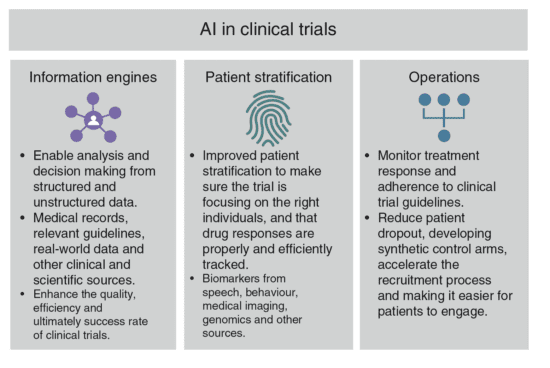Once you find a promising drug or device, you need to take it through trials. This is another long and complicated process. We need to make sure that these products are safe and effective before they’re prescribed to large numbers of people. So many things about this process are difficult: deciding which patient population would be appropriate, finding those patients, designing a good study protocol, recruiting the patients, ensuring that they stay with the study, collecting the right data, analyzing the data, and filing it with the regulatory agencies. That’s a lot, and it usually takes a long time. Life science companies have been looking for a way to improve this process, and it looks like AI could eventually be one of the catalysts to get the right products to the patients safer and faster.
In my new book, AI Doctor: The Rise of Artificial Intelligence in Healthcare, I discuss the many ways AI will eventually improve designing and conducting clinical trials. AI can be helpful in various parts of this process. But it’s not just AI—it’s really data and digital technologies that can transform this long and costly process. AI would be part of the solution. Life science researchers will eventually be able to use machine learning to design optimized trial protocols, identify the best locations for studies, boost patient recruitment, improve adherence to the treatment, and carry out efficient and accurate data analysis.
This is done by extracting structured and unstructured data that’s relevant to the design and conduct of the trial. As we discussed in a previous post, where large language models have a huge impact is in improving the performance of NLP, a discipline in AI that is concerned with analyzing written or spoken language. This is very relevant in clinical trials since much of the information needed to design and perform a clinical trial is unstructured.
NLP can help us to extract and analyze the information we need from a patient’s EHR records, to compare it with the eligibility criteria for all ongoing clinical trials, and to recommend studies that they might be able to participate in. Extracting information from EHRs, labs, images, and other medical records is one of the most highly anticipated use cases of AI in the healthcare industry. The problem is that the solutions that are designed to do this face a range of challenges, such as disparate data sources and unstructured data. Many of the tools that standard NLP algorithms rely on, such as sentiment analysis and word sense disambiguation, struggle with clinical notes because they’re often full of acronyms, misspellings, and technical language.
You can use NLP on clinical notes as a first pass to find patients with the right stage of disease once you know their diagnosis from the ICD-10 codes. For example, if you’re recruiting non-small cell lung cancer patients who are in stage III or IV, the staging information isn’t coded in ICD-10. You’d need to find those patients by examining the clinical notes. Well, this might be a simple enough ask from the less-than-perfect NLP technologies we have access to today.
Solutions are increasingly turning to AI to extract information from medical records to simplify the enrollment process by vetting inclusion and exclusion criteria. Deep 6 AI is using NLP to extract clinical data like diagnoses, symptoms, and treatments from EHRs, and it can even identify patients with conditions that aren’t mentioned in EHRs to improve the match rate between clinical trials and patients.






